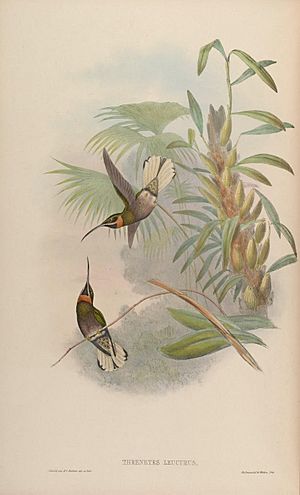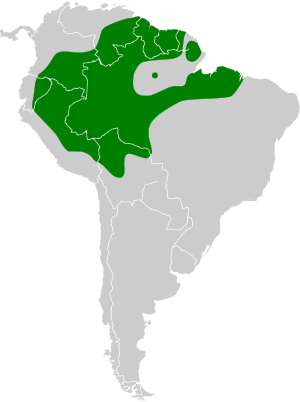Pale-tailed barbthroat facts for kids
Quick facts for kids Pale-tailed barbthroat |
|
|---|---|
 |
|
| Conservation status | |
| Scientific classification | |
| Genus: |
Threnetes
|
| Species: |
leucurus
|
 |
|
| Synonyms | |
|
Trochilus leucurus Linnaeus, 1766 |
|
The pale-tailed barbthroat (Threnetes leucurus) is a type of hummingbird that belongs to the Trochilidae family. You can find it across a large part of the Amazon Basin, from the eastern mountains of the Andes all the way to the Atlantic Ocean.
Contents
Understanding the Pale-tailed Barbthroat
How Scientists Name Animals
Scientists use a system called binomial nomenclature to give every living thing a unique two-part name. This helps everyone know exactly which animal or plant they are talking about. The pale-tailed barbthroat was first officially described by a Swedish naturalist named Carl Linnaeus in 1766. He gave it the name Trochilus leucurus. The name leucurus comes from an old Greek word meaning "white-tailed," which describes one of its features!
Today, this hummingbird is placed in a group (called a genus) named Threnetes.
Different Types of Pale-tailed Barbthroats
Within the pale-tailed barbthroat species, there are four slightly different types, called subspecies. They are:
- T. l. cervinicauda
- T. l. rufigastra
- T. l. leucurus
- T. l. medianus
Scientists sometimes debate how these subspecies are related to other similar hummingbirds, like the sooty barbthroat. They look very much alike, and it can be tricky to tell them apart!
What Does the Pale-tailed Barbthroat Look Like?
The pale-tailed barbthroat is a small bird, usually about 10 to 12.2 centimeters (4 to 4.8 inches) long. Males weigh about 4 to 7 grams (0.14 to 0.25 ounces), and females weigh 4 to 6.5 grams (0.14 to 0.23 ounces).
This hummingbird has bronze-green feathers on its upper body and chest. It has a dark patch near its ear and a dark throat with a reddish spot below it. A pale stripe runs along its cheek. Its tail is dark, but the outer feathers can have different shades of color. The belly is gray with hints of ochre (a yellowish-orange color).
Like other "hermit" hummingbirds, males and females look quite similar. However, the female's beak is a bit more curved than the male's. Young birds look like the adults but have ochre-colored edges on their feathers. The different subspecies can have slight variations in their tail and belly colors.
Where Do Pale-tailed Barbthroats Live?
The pale-tailed barbthroat lives across a wide area in South America. Each subspecies is found in a specific region:
- T. l. cervinicauda lives in eastern Colombia, Ecuador, northeastern Peru, and western Amazonian Brazil.
- T. l. rufigastra is found in eastern Peru (south of the Marañón River) and northern Bolivia.
- T. l. leucurus lives in southern and eastern Venezuela, Guyana, Suriname, and Amazonian Brazil to northeastern Bolivia.
- T. l. medianus is found in northeastern Amazonian Brazil, south of the Amazon River.
These birds prefer open and partly open areas within humid lowland forests. They also live in other places like gallery forest (forests along rivers), swampy forests (like várzea and igapó forests), and even plantations. You can find them from sea level up to about 850 meters (2,800 feet) in Venezuela, and even higher in Peru and Ecuador.
Behavior of the Pale-tailed Barbthroat
Movement and Home Range
The pale-tailed barbthroat is thought to live in the same area all year round. It doesn't usually migrate to different places.
How They Find Food
Like many other hermit hummingbirds, the pale-tailed barbthroat is a "trap-line" feeder. This means it flies a regular route, visiting a circuit of flowering plants to find food. It sips nectar from tubular flowers, especially Heliconia plants. It also eats small arthropods, which are tiny creatures like insects or spiders.
Reproduction and Nesting
The time when pale-tailed barbthroats build nests and lay eggs can vary a lot depending on where they live. Their nest is shaped like a cone-shaped cup. It's made from plant fibers, other soft materials, and spiderwebs. They cover the outside with lichens to help it blend in. The nest is usually attached to the underside tip of a long, drooping leaf, like a palm frond. The female hummingbird is the one who sits on the white eggs to keep them warm until they hatch.
Their Calls and Songs
The pale-tailed barbthroat's song is a fast, high-pitched tune with 5 to 10 notes. They repeat this song every few seconds. Their call is a sharp, high-pitched sound that sounds like "tseet," sometimes doubled.
Conservation Status
The IUCN (International Union for Conservation of Nature) has evaluated the pale-tailed barbthroat and listed it as a species of "Least Concern." This means that scientists are not worried about it becoming endangered anytime soon. It lives across a very large area, and even though its exact population size isn't known, it's believed to be stable. While it might be uncommon in some places, it lives in several protected areas, which helps keep its population safe.
Images for kids
See also
 In Spanish: Ermitaño barbudo colipálido para niños
In Spanish: Ermitaño barbudo colipálido para niños




